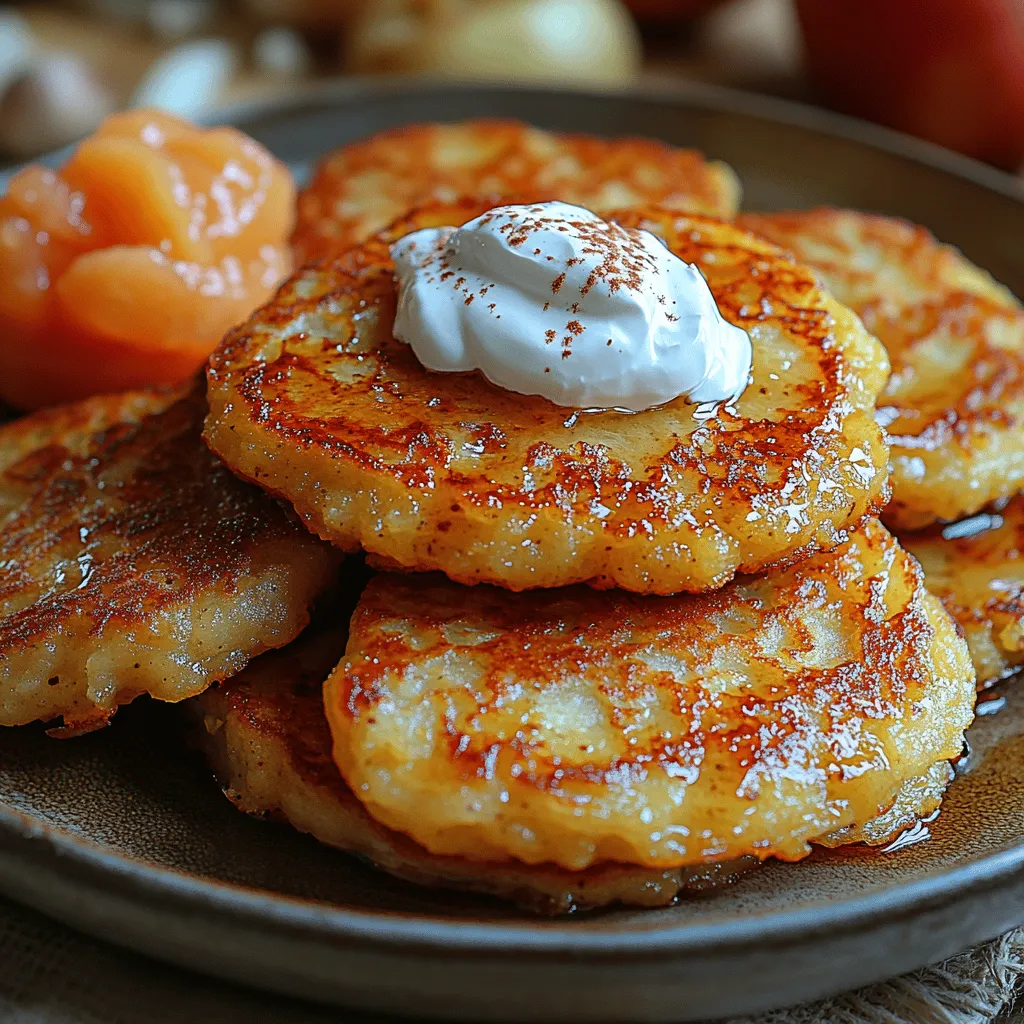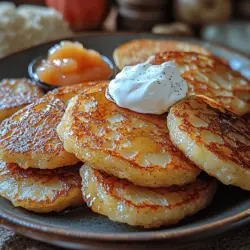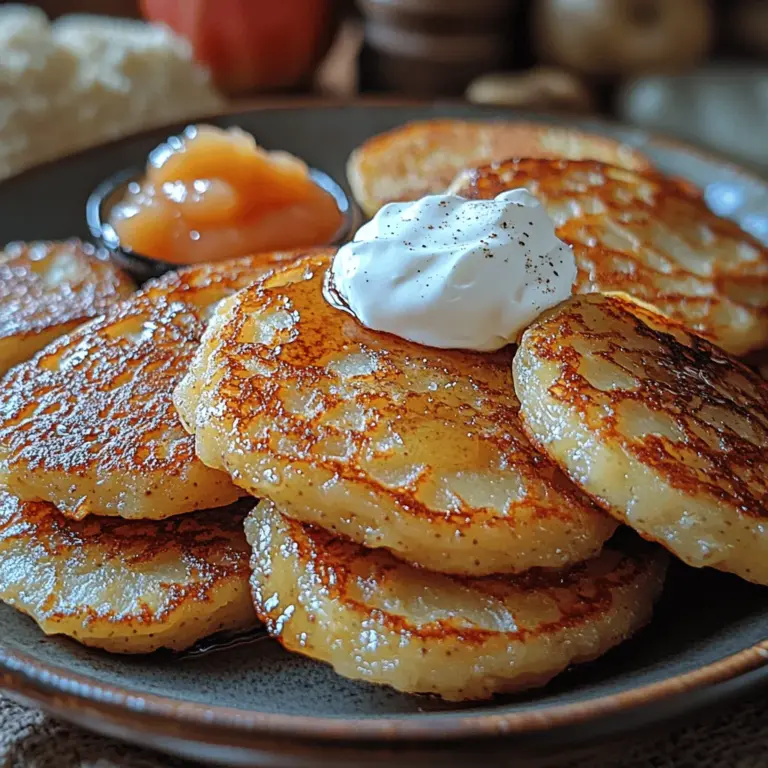Introduction
Crispy and golden brown, potato pancakes are a beloved comfort food that transcends borders and generations. Known by various names—latkes in Jewish cuisine, rösti in Switzerland, and placki ziemniaczane in Poland—these delectable treats have captured the hearts and taste buds of many around the world. The appeal of potato pancakes lies in their delightful crunch and hearty flavor, making them a staple dish in homes and restaurants alike.
The history of potato pancakes is rich and varied. Traditionally, they were a way to utilize leftover potatoes and other pantry staples, resulting in a dish that is not only economical but also incredibly satisfying. In Jewish culture, latkes are especially popular during Hanukkah, symbolizing the miracle of oil. Similarly, in Eastern European countries, potato pancakes are a common fare at family gatherings and holiday celebrations. Regardless of their cultural origins, one thing is clear: potato pancakes are synonymous with comfort and family tradition.
What makes this recipe for Crispy & Golden Classic Potato Pancakes so special is its simplicity. With just a handful of ingredients, you can create something truly delicious that evokes memories of home-cooked meals. The joy of making these pancakes lies not only in their preparation but also in the experience of sharing them with family and friends. So, roll up your sleeves, and let’s dive into the delightful world of potato pancakes!
Understanding the Key Ingredients
To achieve the perfect potato pancake, understanding the role of each ingredient is crucial. The main components include russet potatoes, onion, eggs, flour, and simple seasonings like salt and pepper. Each of these ingredients contributes to the overall texture and flavor of the pancakes.
The Role of Russet Potatoes
When it comes to making potato pancakes, the choice of potato is vital. Russet potatoes are the star of this recipe, and for good reason. Their high starch content makes them ideal for frying, resulting in a crispy exterior and a tender interior. The starch in russet potatoes helps bind the pancake together, ensuring that they hold their shape during cooking. Additionally, russets have a mild flavor that allows the other ingredients to shine.
The Importance of Onion for Flavor Enhancement
Onion is another key ingredient that elevates the flavor of potato pancakes. Whether you choose to use a yellow onion, white onion, or even scallions, the aromatic qualities of onion add depth and complexity to the dish. When sautéed lightly, onion caramelizes and imparts a subtle sweetness that balances the earthiness of the potatoes. Not only does it enhance flavor, but it also contributes to the overall texture of the pancakes.
The Function of Eggs and Flour in Binding the Mixture
Eggs and flour serve as essential binding agents in the potato pancake mixture. Eggs provide structure and stability, allowing the pancakes to hold together during frying. They also add moisture, which is important for achieving a tender texture. Flour, on the other hand, acts as a thickening agent, helping to absorb excess moisture from the potatoes. The combination of eggs and flour ensures that the pancakes are cohesive and easy to handle while frying.
Explanation of Seasonings: Salt and Pepper for Taste
Seasonings like salt and pepper may seem simple, but they play a crucial role in enhancing the overall flavor of the potato pancakes. Salt not only draws out the natural flavors of the ingredients but also helps to balance the dish. A dash of pepper adds a mild heat that complements the other flavors beautifully. Adjusting the seasoning to your taste is important, as it can make a significant difference in the final outcome.
The Essential Preparation Steps
Now that we have an understanding of the key ingredients, let’s delve into the essential preparation steps that will set the foundation for your Crispy & Golden Classic Potato Pancakes. Each step is designed to maximize flavor and texture, ensuring that your pancakes turn out perfectly every time.
Grating the Potatoes
The first step in making potato pancakes is grating the potatoes. This process is crucial, as the texture of the grated potatoes directly impacts the final product. You have two main options for grating: using a box grater or a food processor.
Techniques: Box Grater vs. Food Processor
Using a box grater allows for a more hands-on approach, giving you control over the thickness of the potato shreds. The larger holes create a coarser texture, which can lead to a heartier pancake. On the other hand, a food processor is a time-saving option that produces finely grated potatoes in seconds. The finer texture can result in a smoother pancake, but it’s important to avoid over-processing, as this can turn the potatoes into a purée rather than shreds.
Regardless of the method you choose, aim for a consistent texture. Uneven shreds can lead to pancakes that cook unevenly, resulting in some parts being overly crispy while others remain mushy.
The Impact of Texture on the Final Product
The texture of the grated potatoes is essential for achieving that desired crispiness. Coarse shreds provide more surface area for browning, while finer shreds may yield a softer pancake. Finding the right balance based on your preference is key. If you enjoy a crunchy exterior, opt for a coarser grate. If you prefer a more tender bite, a finer grate may be more suitable.
Draining Excess Moisture
After grating the potatoes, the next step is to drain any excess moisture. This step is crucial for achieving crispy pancakes. If the potato mixture is too wet, the pancakes will steam rather than fry, resulting in a soggy texture.
Importance of Moisture Removal for Crispiness
The goal is to remove as much moisture as possible without sacrificing the integrity of the potatoes. Excess moisture can lead to pancakes that fall apart during cooking, so this step cannot be overlooked. Properly draining the grated potatoes will ensure that your pancakes fry up beautifully golden and crispy.
Methods for Draining: Kitchen Towel vs. Cheesecloth
There are several methods for draining excess moisture from the grated potatoes. One common technique is to use a clean kitchen towel. Simply place the grated potatoes in the center of the towel, gather the edges, and twist to squeeze out the moisture. This method is straightforward and effective, allowing you to control the amount of moisture you remove.
Alternatively, you can use cheesecloth for a similar effect. Place the grated potatoes in the cheesecloth, gather the edges, and twist to remove moisture. This method is particularly useful if you prefer a finer mesh for draining.
Combining the Ingredients
Once you’ve grated and drained the potatoes, it’s time to combine all the ingredients. This step is where the magic happens, transforming individual components into a cohesive mixture ready for frying.
Mixing Techniques for Optimal Consistency
When combining the grated potatoes with the onion, eggs, flour, and seasonings, it’s important to mix gently to avoid breaking down the potato shreds. A light hand will help maintain the texture you’ve worked to achieve.
Start by placing the drained potatoes in a mixing bowl, followed by the grated onion. Add the eggs, flour, salt, and pepper. Use a spatula or wooden spoon to fold the ingredients together gently until just combined. Be cautious not to overmix; you want to maintain the integrity of the potato shreds while ensuring everything is evenly distributed.
As you mix, the starch from the potatoes will help bind the ingredients together, creating a cohesive mixture that holds its shape when formed into pancakes.
With the ingredient preparation complete, you are now ready to begin frying these delicious potato pancakes to perfection. The next steps will guide you through the frying process, ensuring that each pancake is golden brown and irresistibly crispy.
Stay tuned for the next section in our guide to Crispy & Golden Classic Potato Pancakes, where we’ll cover frying techniques and serving suggestions to elevate your homemade dish to new heights!

How to Ensure Even Distribution of Ingredients
To achieve the perfect crispy and golden potato pancake, it’s essential to ensure that your ingredients are evenly distributed. This uniformity not only helps in achieving a consistent texture but also enhances the overall flavor of each pancake. Here are some effective methods to ensure even distribution:
1. Shredding Technique: When shredding your potatoes, use a box grater or food processor to create uniform pieces. This will allow for even cooking and crisping. Be sure to squeeze out excess moisture after shredding to avoid sogginess.
2. Mixing: After combining the shredded potatoes with the other ingredients, use a large spatula or your hands to mix them gently yet thoroughly. This will ensure that the flour, egg, and seasoning are evenly incorporated throughout the potato mixture.
3. Resting Time: Allow the mixture to rest for about 10-15 minutes before cooking. This resting period lets the starches in the potatoes bind with the flour and egg, creating a more cohesive batter that holds together well during frying.
Frying to Perfection
Frying potato pancakes properly is crucial to achieving that desired crispy exterior and fluffy interior. Here are some tips to help you fry your potato pancakes to perfection.
Preparing the Skillet: Oil Temperature and Quantity
The right oil temperature is essential for achieving golden-brown potato pancakes. Here’s how to prepare your skillet:
– Choosing the Oil: Use oils with high smoke points, such as vegetable oil, canola oil, or sunflower oil. These oils can withstand the high temperatures required for frying without burning.
– Heating the Oil: Preheat your skillet over medium-high heat and add enough oil to coat the bottom of the pan (about 1/4 inch deep). To check if the oil is hot enough, drop a small amount of the potato mixture into the oil; if it sizzles immediately, it’s ready for frying.
Techniques for Achieving Golden-Brown Color
Achieving that perfect golden-brown color is not just about the oil temperature; it involves careful frying techniques:
1. Don’t Overcrowd the Pan: Fry the pancakes in batches. Overcrowding the skillet reduces the oil temperature, leading to soggy pancakes instead of crispy ones. Cook 2-3 pancakes at a time based on the skillet size.
2. Pressing Gently: Once you place the potato mixture in the hot oil, gently press down with a spatula. This helps flatten the pancakes, ensuring they cook evenly and develop a crispy surface.
3. Flip with Care: Fry each side for 3-4 minutes or until golden brown. Use a thin spatula to carefully flip the pancakes, being cautious not to break them apart. You can add a little more oil if necessary when flipping.
Tips on Frying in Batches to Maintain Heat
To maintain the oil temperature and ensure perfectly crispy pancakes, follow these tips:
– Monitor the Heat: Keep an eye on the heat while frying. If the oil starts to smoke, it’s too hot. Conversely, if the pancakes aren’t sizzling when added, increase the heat slightly.
– Transfer and Keep Warm: As each batch finishes frying, transfer the pancakes to a wire rack set over a baking sheet. This allows air to circulate around them, preventing them from getting soggy. You can keep them warm in a low oven (around 200°F) while you finish frying the rest.
Serving Suggestions
Potato pancakes are versatile and can be served in various ways. Here are some traditional and creative serving suggestions:
Traditional Accompaniments: Sour Cream vs. Applesauce
The classic toppings for potato pancakes are sour cream and applesauce:
– Sour Cream: The tangy flavor of sour cream complements the crispy pancakes beautifully. For added flavor, consider mixing in fresh herbs like chives or dill.
– Applesauce: For a sweeter contrast, serve your potato pancakes with applesauce. The sweetness of the applesauce balances the savory flavors of the pancakes, making it a popular choice in many households.
Creative Variations: Experimenting with Toppings and Dips
Don’t hesitate to get creative with your toppings:
– Herbed Yogurt Sauce: Mix Greek yogurt with garlic, lemon juice, and fresh herbs for a refreshing dip.
– Avocado Cream: Blend ripe avocado with lime juice and a pinch of salt for a creamy, delicious topping.
– Smoked Salmon: For a more upscale twist, top your potato pancakes with smoked salmon and crème fraîche.
Presentation Tips for a Visually Appealing Dish
Presentation matters! Here are some tips to make your potato pancakes visually appealing:
– Stacking: Stack the pancakes slightly off-center, alternating direction with each layer for a more dynamic look.
– Garnishing: Add a sprinkle of fresh herbs, a dollop of sour cream, or a small serving of applesauce on the side for color and texture.
– Color Contrast: Serve with a vibrant salad or colorful vegetables to create a visually striking plate.
Nutritional Benefits of Potato Pancakes
Potato pancakes, while delicious, also provide several nutritional benefits when made with wholesome ingredients. Here’s a closer look:
Overview of the Nutritional Content of the Main Ingredients
– Potatoes: A great source of carbohydrates and fiber, potatoes also provide essential vitamins and minerals, including vitamin C, potassium, and vitamin B6.
– Eggs: Eggs add protein and healthy fats, contributing to satiety and helping to bind the pancake mixture together.
– Onions: Adding onions not only enhances flavor but also provides antioxidants that support overall health.
Discussion on Portion Control and Balanced Meals
While potato pancakes can be a delightful treat, portion control is key:
– Serving Size: Aim for 2-3 pancakes per serving, depending on their size. Pair them with a side salad or steamed vegetables to create a well-rounded meal.
– Balanced Meals: Consider adding a protein source, such as grilled chicken or fish, to round out your meal. This will help balance your plate and provide a variety of nutrients.
Considerations for Dietary Restrictions and Alternatives
For those with dietary restrictions, there are alternatives to make potato pancakes more inclusive:
– Gluten-Free: Substitute all-purpose flour with gluten-free flour blends or almond flour to cater to gluten sensitivities.
– Vegan Option: Replace the egg with a flaxseed meal mixture (1 tablespoon of flaxseed meal mixed with 2.5 tablespoons of water, let sit for 5 minutes) to bind the ingredients together.
Cultural Variations of Potato Pancakes
Potato pancakes are beloved in many cultures around the world, each with its unique twist. Here are a few notable variations:
Exploration of Similar Dishes in Different Cultures
– Latkes: In Jewish culture, latkes are traditionally made during Hanukkah, often served with applesauce and sour cream. They are typically made with russet potatoes and have a crispy exterior.
– Rösti: A Swiss dish, rösti is similar to potato pancakes but is often made with grated potatoes and served as a side dish or breakfast item, sometimes topped with cheese or eggs.
– Draniki: In Belarus, draniki are a traditional dish made from grated potatoes and served with sour cream. They often include additional ingredients like carrots or mushrooms for extra flavor.
Unique Variations and Regional Adaptations of Potato Pancakes
– Hash Brown Patties: In the United States, hash browns are a breakfast staple, often served as patties that resemble potato pancakes but are typically fried until crispy.
– Korean Gamja-jeon: This Korean version of potato pancakes includes grated potatoes, scallions, and sometimes kimchi, offering a spicy twist to the classic recipe.
Conclusion
Crispy potato pancakes embody the essence of comfort food. They are not only a delightful dish to prepare but also a joy to share with family and friends. The process of grating, mixing, frying, and serving creates an inviting atmosphere, perfect for gatherings or simple family meals.
Whether you stick to traditional toppings like sour cream and applesauce or experiment with creative variations, making crispy potato pancakes is an experience that brings warmth and nostalgia to the table.
So, gather your ingredients, follow the steps, and take pleasure in the satisfying crunch of homemade potato pancakes. They are a timeless dish that holds a special place in home cooking, inviting everyone to savor the flavors and memories they bring. Try this recipe today and discover the joy of cooking a classic comfort food that will surely become a favorite in your household.

